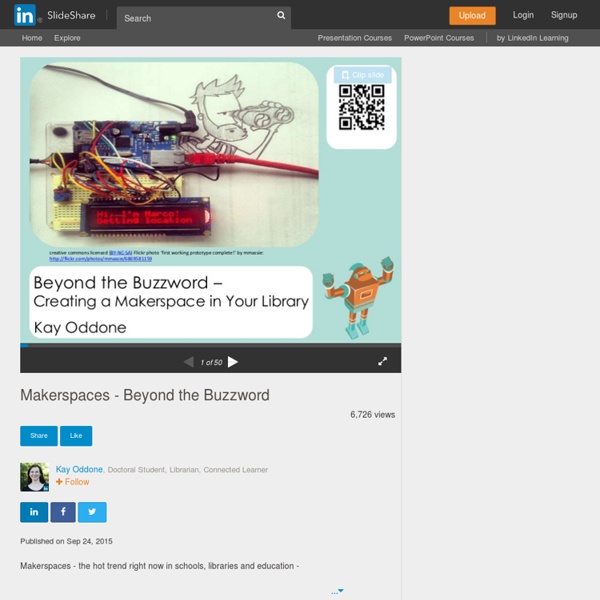



https://www.slideshare.net/kayc28/makerspaces-beyond-the-buzzword
Related: MakerspaceWant to Start a Makerspace at School? Tips to Get Started As the Maker Movement starts to gain momentum, schools that are trying to find ways to foster the do-it-yourself environment can learn a few lessons from another nexus in the universe: public libraries. Dale Dougherty, founding editor and publisher of Make Magazine — and the de facto leader of the Maker Movement — has a vision to create a network of libraries, museums, and schools with what he calls “makerspaces” that draw on common resources and experts in each community. Libraries and museums, he said, are easier places to incorporate makerspaces than schools, because they have more space flexibility and they’re trying to attract teens with their programs. “Schools have already got the kids,” Dougherty noted wryly, at the recent American Library Association Midwinter Meeting in Seattle. One day during the conference, dubbed Maker Monday, focused on the Maker Movement, which emphasizes learning by engaging in tech-related projects. “Why are you here?”
What is PBL? To help teachers do PBL well, we created a comprehensive, research-based model for PBL — a "gold standard" to help teachers, schools, and organizations to measure, calibrate, and improve their practice. In Gold Standard PBL, projects are focused on student learning goals and include Essential Project Design Elements: Baby Steps to creating a Makerspace in the Library Makerspaces in Your Library When I entered Fields Elementary Library, it was traditional in every way. Slowly, I have worked to make it a learning space, one where I can share technology and create a community of shared learning. Gone are the days that the library is just a place to check in and check out books. Since McAllen ISD is a 1:1 district, I am thrilled to see the potential every student has in this space. When I interviewed a month ago for this library position, my principal asked what my vision was for the library.
(Rethinking) Makerspaces Kids have always made in my library. We encouraged digital and visual and dramatic and rhetorical creativity before, during, and after school. But for a while, I’ve questioned the value of using already heavily used real estate to randomly carve out space for a 3D printer, electronics stations and sewing machines. I had my doubts about the makerspace movement in school libraries.
Makerspace Starter Kit The hot new Makerspace Movement is NOT new to Murray Hill Middle School. Eighteen years ago we designed and opened the school with the idea that we would have creation labs in the Media Center, GT room, and the TV studio. We started with video production, iMovie, Specular LogoMotion, Hyperstudio, and animation with Hollyood High kids. Here's an example of an EARLY (2003) video production called Bookfellas, featuring some Guy Ritchie-esque film direction techniques. These kids are now all grown up and we've kept evolving, too!
5 Keys to Rigorous Project-Based Learning Five Keys Video Series See Edutopia's core strategies in action with our Five Keys video series. Take a deeper look at each strategy as we share the nuts and bolts of program implementation, give voice to examples from schools around the country, and illuminate the research behind the practices. VIDEO: Establishing Real-World Connections in Projects (Keys to PBL Series Part 1) Students are more engaged when learning relates directly to the world they live in. See how to extend your projects beyond classroom walls.
Evolution of a Maker Space, From “Monstie Stuffie” Projects to a Giant Catapult littleBits activities at the circulation desk in Colleen Graves’s school library. Two years ago, I was asked to write an article for Knowledge Quest about how I created a maker space at Lamar Middle School in Flower Mound, TX. That first year of programming is so different from what I do now that I thought it pertinent to chart how our maker programming (#Makered) has evolved. During my first year as a librarian in 2012–13 my Teen Advisory Board (TAB) helped me redecorate a small office located behind our circulation desk. My director bought us some reading rockers, chalkboard paint, rain gutters, and 25 licenses for Minecraft. How to Start a Makerspace When You're Broke Everyone’s Favorite Excuse I’ve had the honor and privilege of sharing with hundreds of librarians and educators about our makerspace. Unfortunately, I see many educators hold back on starting a makerspace because of funds. I’m always hearing excuses like:
Creating a School Library Makerspace: The Beginning of a Journey Our library at Silver Creek High School in Longmont, CO is an active hub for extracurricular activities. We host an Anime Club, monthly Poetry Slams, and Book Buddies, but I felt like we could do more. I wanted something that I could tie to student learning which would promote inquiry, giving students opportunities to solve problems and find answers to questions. My assistant and I began looking at innovative library programs and community partnerships. Many of the teacher librarians in my professional network have been expanding their libraries by adding makerspace opportunities, classroom collaboration, and even 3-D printers. I used these folks as inspiration.